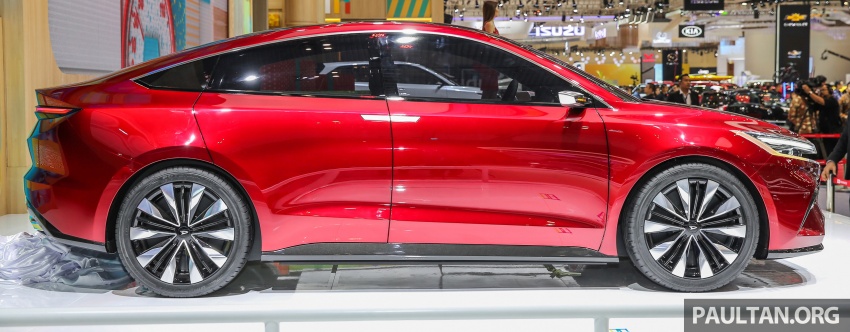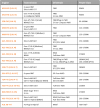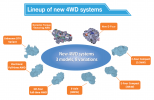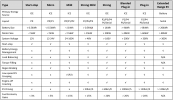You are using an out of date browser. It may not display this or other websites correctly.
You should upgrade or use an alternative browser.
You should upgrade or use an alternative browser.
Official Lexus Future Product & Powertrain Megathread
- Thread starter ssun30
- Start date

Toyota Vios 2022 D92A spyshots - DNGA platform, official debut in Q3
A prototype of the next-generation Toyota Vios has been spotted undergoing testing in Bangkok ahead of an official world debut expected to take place in Thailand in the third quarter of this year, Headlightmag reports. …
Concept was good looking, also in red reminds me of A3 Sedan concept.The Vios has always been a Toyota only model from the ground up, so not really sure why certain car websites are spreading rumours that the upcoming generation is going to become a Daihatsu underneath its surface, they even kinda contradict themselves with some of the other things that they are saying, like why would they build this car using Daihatsu's platform but then try to stuff in THS II for the hybrid model? If it really is using Daihatsu's platform they'd be using Daihatsu's e-smart hybrid instead. Also, just looking at the proportions of this Vios prototype's exterior especially the length and height of the front end, it looks nothing like the unusually short and stubby front end of the Daihatsus built on the DNGA platform, then again the car websites from my part of the world are known to be extremely whack.
Toyota Vios 2022 D92A spyshots - DNGA platform, official debut in Q3
A prototype of the next-generation Toyota Vios has been spotted undergoing testing in Bangkok ahead of an official world debut expected to take place in Thailand in the third quarter of this year, Headlightmag reports. …paultan.org

Sorry to dump cold water on some of you(kerb your knee jerk), but that concept car has nothing to do with the Vios, it might look quite big in pictures but that concept is actually an A-segment car(even smaller than B-segment/sub-compact), the Vios is a B-segment car, plus there were no real plans to make a production version of this concept carConcept was good looking, also in red reminds me of A3 Sedan concept.

https://www.wapcar.my/news/daihatsu-no-future-for-indo-perodua-bezza-dn-fsedan-concept-killed-4646
Again, no idea how some of these car websites are linking a bunch of unrelated and even contradicting things together.
maiaramdan
Expert
- Messages
- 1,836
- Reactions
- 1,423
@carguy420 , agree but even though it looks good design wise
With the launch of Gen5 RX500h and upcoming Chinese-market Highlander D-4ST, the puzzle of the 2018 powertrain plans published by Toyota is close to complete. The new TNGA family of powertrains started with the Gen.4 1.8L THS-II in the 2016 Prius, and six years later refresh of the lineup begins with the Gen.5 1.8L THS-II in the 2022 Noah. Note the 3.5L V6-TT hybrid system on the new Tundra/Sequoia is not marketed as a hybrid system, but as an engine option "i-Force Max", presumably because it doesn't offer substantial fuel economy gains.

Here is a full table of all powertrain combinations of the TNGA family:

There are still a few missing components that are reportedly under development:
1) Longitudinal T24-FTS P2 hybrid system, rumored for next-gen Tacoma/4Runner/LCP/GX.
2) Transverse T24-FTS P2 plug-in hybrid system, rumored for TX550h+.
3) 2.8L I4 twin-turbo diesel, rumored for next-gen Hilux/Fortuner/LCP.
4) F33-FTV P2 hybrid system, rumored for LC300/LX hybrid in diesel markets.
5) Flagship F-car powertrain with plug-in hybrid 4.0L V8-TT engine, rumored for "LFA 2".
And finally, 7 out of the 8 AWD systems have been launched. There is one unknown variant of the Dynamic Torque Vectoring AWD system yet to be released. It is not DTC/ATC since these are pre-TNGA technologies.


Here is a full table of all powertrain combinations of the TNGA family:

There are still a few missing components that are reportedly under development:
1) Longitudinal T24-FTS P2 hybrid system, rumored for next-gen Tacoma/4Runner/LCP/GX.
2) Transverse T24-FTS P2 plug-in hybrid system, rumored for TX550h+.
3) 2.8L I4 twin-turbo diesel, rumored for next-gen Hilux/Fortuner/LCP.
4) F33-FTV P2 hybrid system, rumored for LC300/LX hybrid in diesel markets.
5) Flagship F-car powertrain with plug-in hybrid 4.0L V8-TT engine, rumored for "LFA 2".
And finally, 7 out of the 8 AWD systems have been launched. There is one unknown variant of the Dynamic Torque Vectoring AWD system yet to be released. It is not DTC/ATC since these are pre-TNGA technologies.

Longitudinal T24-FTS P2 hybrid system, rumored for next-gen Tacoma/4Runner/LCP/GX.
Would that system work with the GX crowd? The conservative tuning that Lexus's does not pay dividends the way it should even though the system would have higher output then the the 301/329 current?
Would that system work with the GX crowd? The conservative tuning that Lexus's does not pay dividends the way it should even though the system would have higher output then the the 301/329 current?
F1 Silver Arrows
Expert
- Messages
- 2,566
- Reactions
- 4,170
With the launch of Gen5 RX500h and upcoming Chinese-market Highlander D-4ST, the puzzle of the 2018 powertrain plans published by Toyota is close to complete. The new TNGA family of powertrains started with the Gen.4 1.8L THS-II in the 2016 Prius, and six years later refresh of the lineup begins with the Gen.5 1.8L THS-II in the 2022 Noah. Note the 3.5L V6-TT hybrid system on the new Tundra/Sequoia is not marketed as a hybrid system, but as an engine option "i-Force Max", presumably because it doesn't offer substantial fuel economy gains.
View attachment 5968
Here is a full table of all powertrain combinations of the TNGA family:
View attachment 5970
There are still a few missing components that are reportedly under development:
1) Longitudinal T24-FTS P2 hybrid system, rumored for next-gen Tacoma/4Runner/LCP/GX.
2) Transverse T24-FTS P2 plug-in hybrid system, rumored for TX550h+.
3) 2.8L I4 twin-turbo diesel, rumored for next-gen Hilux/Fortuner/LCP.
4) F33-FTV P2 hybrid system, rumored for LC300/LX hybrid in diesel markets.
5) Flagship F-car powertrain with plug-in hybrid 4.0L V8-TT engine, rumored for "LFA 2".
And finally, 7 out of the 8 AWD systems have been launched. There is one unknown variant of the Dynamic Torque Vectoring AWD system yet to be released. It is not DTC/ATC since these are pre-TNGA technologies.
View attachment 5971
Ah, I missed having something like this again. The old thread was so damn old that I've forgotten about it. This put a huge smile on my face.
I'm just going to compare what's available now compared to what the last thread predicted four years ago.
What I and other forum contributors got right:
1) There will be a 1.5L THS-II small hybrid system with similar output to 1.8L THS-II.
2) There will be a 2.0T engine with 180kW/241hp. My number was off by 1kW.
3) The 'main workhorse engine' will be a ~2.5T (turns out to be 2.4L). The maximum power powertrain based on this engine will be 270kW (RX500h has 267kW). My number was off by 3kW.
3.5) No more V6 engine of ES/NX/RX as it's replaced by 2.5T.
4) A high-power transverse hybrid powertrain using a turbocharged engine.
5) This is not confirmed but we can kind of agree the 4.0L V8-TT will happen.
6) A V35A-FTS based hybrid system coming after 2021.
7) There will be a 350h for Highlander Hybrid with more power than the 300h predicted by @spwolf.
8) 1KR and 8NR engine would stay in production without direct replacement as predicted by @spwolf.
9) Toyota was committed to a new lineup of diesel powertrain predicted by @Gecko.
What I got wrong:
1) All the designations. Back then I had no idea how their new naming system worked.
2) I didn't believe Toyota would build any large-displacement Inline-3 let alone two. I expected a 1.0L I3-T (turned out to be 1.5L I3 NA) and 1.6L I4-T (turned out to be 1.6L I3-T).
3) I expected the 2.0T engine to be a mainstream application and the most important engine in the lineup. In reality it is the last DF engine released and limited to Chinese market Highlander only. I expected it to be used on IS300, NX300 and RX300. But IS kept using old 8AR-FTS, and NX/RX uses the larger T24.
4) I expected the 1.5L hybrid to replace the 1.8L hybrid because their power levels will be similar. Instead Toyota upgraded the 1.8L system to Gen.5 and now makes a lot more power than the 1.5L Gen.4 system.
5) The engine between V35 and V8-TT turned out to be F33 diesel. I predicted it to be a low-power V8-TT. To be fair back then we all hoped a low-power V8 would still happen for the LS/LX/LC.
6) The T24-FTS turned out to be less powerful, but more torquey than predicted (I expected 225-240kW/400-420N.m but turned out to be 197-205kW/420-460N.m).
It seems the general theme about the turbocharged DF engines are high specific torque but moderate specific power. In the end it works for their buyer demographic. The average NX/RX driver will likely never use 4000+rpm but a very usable torque band is more relevant to them.
Let's just say we got better predictions four years ago than a certain "social media influencer" who boasts about his spreadsheet skills but still couldn't get the numbers right just a few months before product launch.
What I and other forum contributors got right:
1) There will be a 1.5L THS-II small hybrid system with similar output to 1.8L THS-II.
2) There will be a 2.0T engine with 180kW/241hp. My number was off by 1kW.
3) The 'main workhorse engine' will be a ~2.5T (turns out to be 2.4L). The maximum power powertrain based on this engine will be 270kW (RX500h has 267kW). My number was off by 3kW.
3.5) No more V6 engine of ES/NX/RX as it's replaced by 2.5T.
4) A high-power transverse hybrid powertrain using a turbocharged engine.
5) This is not confirmed but we can kind of agree the 4.0L V8-TT will happen.
6) A V35A-FTS based hybrid system coming after 2021.
7) There will be a 350h for Highlander Hybrid with more power than the 300h predicted by @spwolf.
8) 1KR and 8NR engine would stay in production without direct replacement as predicted by @spwolf.
9) Toyota was committed to a new lineup of diesel powertrain predicted by @Gecko.
What I got wrong:
1) All the designations. Back then I had no idea how their new naming system worked.
2) I didn't believe Toyota would build any large-displacement Inline-3 let alone two. I expected a 1.0L I3-T (turned out to be 1.5L I3 NA) and 1.6L I4-T (turned out to be 1.6L I3-T).
3) I expected the 2.0T engine to be a mainstream application and the most important engine in the lineup. In reality it is the last DF engine released and limited to Chinese market Highlander only. I expected it to be used on IS300, NX300 and RX300. But IS kept using old 8AR-FTS, and NX/RX uses the larger T24.
4) I expected the 1.5L hybrid to replace the 1.8L hybrid because their power levels will be similar. Instead Toyota upgraded the 1.8L system to Gen.5 and now makes a lot more power than the 1.5L Gen.4 system.
5) The engine between V35 and V8-TT turned out to be F33 diesel. I predicted it to be a low-power V8-TT. To be fair back then we all hoped a low-power V8 would still happen for the LS/LX/LC.
6) The T24-FTS turned out to be less powerful, but more torquey than predicted (I expected 225-240kW/400-420N.m but turned out to be 197-205kW/420-460N.m).
It seems the general theme about the turbocharged DF engines are high specific torque but moderate specific power. In the end it works for their buyer demographic. The average NX/RX driver will likely never use 4000+rpm but a very usable torque band is more relevant to them.
Let's just say we got better predictions four years ago than a certain "social media influencer" who boasts about his spreadsheet skills but still couldn't get the numbers right just a few months before product launch.
Some additional information about hybrids just in case new forum members are unfamiliar with a lot of the terminologies we use in our discussions.
1) Comparison of different types of hybrid systems. Note I added two extra personal categories "strong mild" and "blended plug-in". The former refers to strong hybrids with undersized motors/batteries, but are more capable than mild hybrids. Examples are F-150 Powerboost and Tundra i-Force Max. The latter refers to plug-in hybrids with poor EV driving capability and requires ICE assist ("blended mode") to drive on highway. Examples are Honda Clarity PHV and many Mercedes/BMW PHVs.

2) Schematics of 5 different layouts for parallel hybrid systems. Hybrid Layouts are different from hybrid types: a P0 hybrid can either be micro or mild hybrid. A P2 hybrid can be mild, strong mild, strong, blended plug-in or full plug-in hybrid. The most common types are P2 and P4, and the rarest are P1 and P3.

1) Comparison of different types of hybrid systems. Note I added two extra personal categories "strong mild" and "blended plug-in". The former refers to strong hybrids with undersized motors/batteries, but are more capable than mild hybrids. Examples are F-150 Powerboost and Tundra i-Force Max. The latter refers to plug-in hybrids with poor EV driving capability and requires ICE assist ("blended mode") to drive on highway. Examples are Honda Clarity PHV and many Mercedes/BMW PHVs.

2) Schematics of 5 different layouts for parallel hybrid systems. Hybrid Layouts are different from hybrid types: a P0 hybrid can either be micro or mild hybrid. A P2 hybrid can be mild, strong mild, strong, blended plug-in or full plug-in hybrid. The most common types are P2 and P4, and the rarest are P1 and P3.

Thanks for all the work with this. This is great info.
My understanding is that this is a chart for dynamic force engines, so a couple questions related to this:
Is the 1.6 I3 considered a DF engine? Wiki says no, but then again, it’s wiki. I don’t know what makes an engine DF or not.
Based on the old powertrain thread, I was under the assumption that Diesel engines were not part of this chart. Is that no longer the case? Is the F33 a DF engine? Wasn’t there a new 4 cylinder diesel in the works too?
Personally, I think we will still see another TT V6 in the 2.8-3.0L range, but maybe that’s just wishful thinking on my part.
This is all fascinating stuff! I’m really excited to see what the future of Lexus/Toyota holds for us.
My understanding is that this is a chart for dynamic force engines, so a couple questions related to this:
Is the 1.6 I3 considered a DF engine? Wiki says no, but then again, it’s wiki. I don’t know what makes an engine DF or not.
Based on the old powertrain thread, I was under the assumption that Diesel engines were not part of this chart. Is that no longer the case? Is the F33 a DF engine? Wasn’t there a new 4 cylinder diesel in the works too?
Personally, I think we will still see another TT V6 in the 2.8-3.0L range, but maybe that’s just wishful thinking on my part.
This is all fascinating stuff! I’m really excited to see what the future of Lexus/Toyota holds for us.
I'm just going to compare what's available now compared to what the last thread predicted four years ago.
What I and other forum contributors got right:
1) There will be a 1.5L THS-II small hybrid system with similar output to 1.8L THS-II.
2) There will be a 2.0T engine with 180kW/241hp. My number was off by 1kW.
3) The 'main workhorse engine' will be a ~2.5T (turns out to be 2.4L). The maximum power powertrain based on this engine will be 270kW (RX500h has 267kW). My number was off by 3kW.
3.5) No more V6 engine of ES/NX/RX as it's replaced by 2.5T.
4) A high-power transverse hybrid powertrain using a turbocharged engine.
5) This is not confirmed but we can kind of agree the 4.0L V8-TT will happen.
6) A V35A-FTS based hybrid system coming after 2021.
7) There will be a 350h for Highlander Hybrid with more power than the 300h predicted by @spwolf.
8) 1KR and 8NR engine would stay in production without direct replacement as predicted by @spwolf.
9) Toyota was committed to a new lineup of diesel powertrain predicted by @Gecko.
What I got wrong:
1) All the designations. Back then I had no idea how their new naming system worked.
2) I didn't believe Toyota would build any large-displacement Inline-3 let alone two. I expected a 1.0L I3-T (turned out to be 1.5L I3 NA) and 1.6L I4-T (turned out to be 1.6L I3-T).
3) I expected the 2.0T engine to be a mainstream application and the most important engine in the lineup. In reality it is the last DF engine released and limited to Chinese market Highlander only. I expected it to be used on IS300, NX300 and RX300. But IS kept using old 8AR-FTS, and NX/RX uses the larger T24.
4) I expected the 1.5L hybrid to replace the 1.8L hybrid because their power levels will be similar. Instead Toyota upgraded the 1.8L system to Gen.5 and now makes a lot more power than the 1.5L Gen.4 system.
5) The engine between V35 and V8-TT turned out to be F33 diesel. I predicted it to be a low-power V8-TT. To be fair back then we all hoped a low-power V8 would still happen for the LS/LX/LC.
6) The T24-FTS turned out to be less powerful, but more torquey than predicted (I expected 225-240kW/400-420N.m but turned out to be 197-205kW/420-460N.m).
It seems the general theme about the turbocharged DF engines are high specific torque but moderate specific power. In the end it works for their buyer demographic. The average NX/RX driver will likely never use 4000+rpm but a very usable torque band is more relevant to them.
Let's just say we got better predictions four years ago than a certain "social media influencer" who boasts about his spreadsheet skills but still couldn't get the numbers right just a few months before product launch.
spreadsheet lmao......let me guess.......is that person the most beloved youtuber whose name starts with, k?
Personally, I think we will still see another TT V6 in the 2.8-3.0L range, but maybe that’s just wishful thinking on my part.
This is all fascinating stuff! I’m really excited to see what the future of Lexus/Toyota holds for us.
Never will happen. They had the chance to do it with the new RX FSP but it didn't happen.
Will1991
Moderator
- Messages
- 1,605
- Reactions
- 3,269
@ssun30 , excellent work!
Can I make a small suggestion? On your P4 hybrid system, it seems the electric motor "helps" the engine (almost like a P3 system), but on P4 systems they aren't connected. Perhaps erasing the blue line between the gearbox and differential?
Well... Toyota did published some patents regarding water injection on turbo engines.... So I wouldn't say a higher performance version is coming...
Or it's going to appear on the:
Good times to be a LE!
Can I make a small suggestion? On your P4 hybrid system, it seems the electric motor "helps" the engine (almost like a P3 system), but on P4 systems they aren't connected. Perhaps erasing the blue line between the gearbox and differential?
6) The T24-FTS turned out to be less powerful, but more torquey than predicted (I expected 225-240kW/400-420N.m but turned out to be 197-205kW/420-460N.m).
It seems the general theme about the turbocharged DF engines are high specific torque but moderate specific power. In the end it works for their buyer demographic. The average NX/RX driver will likely never use 4000+rpm but a very usable torque band is more relevant to them.
Well... Toyota did published some patents regarding water injection on turbo engines.... So I wouldn't say a higher performance version is coming...
Or it's going to appear on the:
5) Flagship F-car powertrain with plug-in hybrid 4.0L V8-TT engine, rumored for "LFA 2".
Good times to be a LE!
Last edited:
larryren
Follower
- Messages
- 124
- Reactions
- 227
Thanks to @ssun30 for summarizing data and tables!
I have agreed 1.5H system will replace 1.8H system before. Because some internal message from bidding Information said TFTE are ready for coverting production plan and same power output with 1.8H system. But also know Chinese market don't like 3-cylinders engine, now raising motor output are still make 1.8H system competitive and keeping low cost production. 2.0 system is the same reason raising system output to 197PS it keep competitive with Honda 2.0 direct inject iMMD at compact segment.
I have agreed 1.5H system will replace 1.8H system before. Because some internal message from bidding Information said TFTE are ready for coverting production plan and same power output with 1.8H system. But also know Chinese market don't like 3-cylinders engine, now raising motor output are still make 1.8H system competitive and keeping low cost production. 2.0 system is the same reason raising system output to 197PS it keep competitive with Honda 2.0 direct inject iMMD at compact segment.
Gecko
Administrator
- Messages
- 5,145
- Reactions
- 12,640
Never will happen. They had the chance to do it with the new RX FSP but it didn't happen.
I agree. We have:
T24A: 275hp/317lb-ft (NX, RX)
V35A-FTS low tune: 348hp/405lb-ft (Tundra SR, probably 4Runner, Tacoma, GX)
T24A + hybrid: 367hp/406lb-ft (RX 500h FSP)
V35A-FTS mid tune: 416hp/442lb-ft (LS 500)
V35A-FTS high tune: 409hp/479lb-ft (LX 600)
V35A-FTS + hybrid: ~437hp/583lb-ft (Tundra iFORCE max)
That lineup is full from 275hp up to 437hp, so there is no need for another V6.
You are right. For simplicity of making that figure I used a longitudinal layout. P4 isn't very feasible on a longitudinal RWD car.@ssun30 , excellent work!
Can I make a small suggestion? On your P4 hybrid system, it seems the electric motor "helps" the engine (almost like a P3 system), but on P4 systems they aren't connected. Perhaps erasing the blue line between the gearbox and differential?
That P4 figure is a mistake, it is indeed a P3. What makes more sense is a FWD with an electric rear axle, or RWD with electric front axle.
P3 in general is a very undesirable layout since the motor's torque is multiplied only by the final drive. But in P2 the motor's torque is multiplied by the transmission too. P4 also gets extra multiplication from the direct drive gear. As a result P3 is very weak compared to P2/4. The only advantage I can think of is it doesn't need transmission redesign (P2 transmission needs much stronger clutch pack/torque converter).
Last edited:
Never will happen. They had the chance to do it with the new RX FSP but it didn't happen.
I would not have expected any V6 in the RX since it seems Toyota/Lexus is ditching the V6 in all transverse configurations. I think there’s room in the lineup for a 2.8-3.0L TT V6 in TNGA-L platforms, as well as whatever TNGA platform underpins the next 4Runner/GX/Prado/Tacoma.
I also have a hard time seeing the TX powered solely by the T24, even if it’s a hybrid. A TNGA-L based TX with a TT V6 makes more sense to me.
-
This site uses cookies to help personalise content, tailor your experience and to keep you logged in if you register.
By continuing to use this site, you are consenting to our use of cookies.
